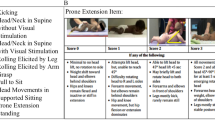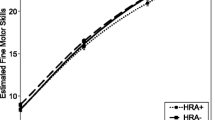Abstract
The development of fine motor and adaptive skills during the first 2 years of life is reported in 97 highrisk preterm children and 94 healthy term children. Most stages of fine motor and adaptive development were found to occur at slightly later ages among preterm children. Neurological development was significantly correlated with fine motor and adaptive development in preterm children only. No significant influence of prenatal, perinatal and postnatal variables on fine motor and adaptive development was noted. No significant sex differences were observed in both the term and preterm group. The strongest predictors of later intellectual functioning were fine motor performance at 9 months and fine motor and adaptive skills at 18 to 24 months.
Similar content being viewed by others
Abbreviations
- AGA:
-
appropriate for gestational age
- SES:
-
socio-economic status
References
Angermaier M (1974) Psycholinguistischer Entwicklungstest. Beltz Test, Weinheim
Bretherton I (1984) Symbolic play. The development of social understanding. Academic Press, New York
Bruner JS (1970) Growth and structure of skill. In: Connolly KJ (ed) Mechanisms of motor skill development. Academic Press, New York
Bruner JS, Bruner BM (1968) On voluntary action and its hierarchical structure. Int J Psychol 3: 239–255
Bruner JS, Jolly A, Sylva K (1976) Play. Its role in development and evolution. Basic Books, New York
Dubowitz LMS, Dubowitz V, Goldberg C (1970) Clinical assessment of gestational age in the newborn infant. J Pediatr 77: 1–10
Egan DF (1986) Developmental assessment 18 months to 4 1/2 years. Performance tests. Child Care Health Dev 12: 339–349
Egan DF, Brown ER (1984) Developmental assessment: 18 months to 4 1/2 years. The bus puzzle test. Child Care Health Dev 10: 163–179
Eggert D, Schuch KD (1975) Hannover Wechsler Intelligenztest für das Vorschulalter. Hans Huber, Bern
Gesell A, Amatruda CS (1947) Developmental diagnosis. Harper and Row, New York
Görlitz D, Wohlwill JF (1987) Curiosity, imagination and play. Lawrence Erlbaum Associates, Hillsdale
Griffiths R (1954) The abilities of babies. University of London Press, London
Halverson HM (1931) An experimental study of prehension in infants by means of systematic cinema records. Genet Psychol Monogr 10: 107–284
Honzik MP (1976) Value and limitations of infant tests: an overview. In: Lewis M (ed) The origins of intelligence. Plenun Press, New York, pp 59–95
Knobloch H, Pasamanick B (1963) Predicting intellectual potential in infancy. Am J Dis Child 106: 43–51
Kopp CB (1974) Fine motor abilities in infants. Dev Med Child Neurol 16: 629–636
Largo RH, Howard JA (1979) Developmental progression of play behaviors in children 9 to 30 months of age. I. Spontaneous play and imitation. Dev Med Child Neurol 21: 299–310
Largo RH, Wälli R, Duc G, Fanconi A, Prader A (1980) Evaluation of perinatal growth. Helv Paediatr Acta 35: 419–436
Largo RH, Molinari L, Weber M, Comenale-Pinto L, Duc G (1985) Early development of locomotion: significance of prematurity, cerebral palsy and sex. Dev Med Child Neurol 27: 183–191
Largo RH, Molinari L, Comenale-Pinto L, Weber M, Duc G (1986) Language development of term and preterm children during the first five years of life. Dev Med Child Neurol 28: 333–350
Largo RH, Pfister D, Molinari L, Kundu S, Lipp A, Duc G (1989) Significance of prenatal, perinatal and postnatal factors in the developmental of AGA-preterm infants at five to seven years. Dev Med Child Neurol 31: 440–456
Largo RH, Graf S, Kundu S, Hunziker U, Molinari L (1990a) Predicting developmental outcome at school age from infant tests of normal, at-risk and retarded infants. Dev Med Child Neurol 32: 30–45
Largo RH, Molinari L, Kundu S, Hunziker U, Duc G (1990b) Neurological outcome in high risk appropriate for gestational age preterm children at early schoolage. Eur J Pediatr 149: 835–841
Largo RH, Molinari L, Kundu S, Lipp A, Duc G (1990c) Intellectual outcome, speech and school performance in high risk appropriate for gestational age preterm children. Eur J Pediatr 149: 845–850
Lundberg A (1979) Gross and fine motor performance in healthy Swedish children aged fifteen and eighteen months. Neuropediatr 10: 35–50
Michel GF, Ovrut MR, Harkins DA (1985) Hand-use preference for reaching and object manipulation in 6- through 13-month-old infants. Genet Psychol Monogr 111: 407–427
Moss SC, Hogg J (1983) The development and integration of fine motor sequences in 12- to 18-month-old children: a test of the modular theory of motor skill acquisition. Genet Psychol Monogr 107: 145–187
Piaget J (1952) The origins of intelligence in children. International University Press, New York
Piper MC, Byrne PJ, Darrah J, Watt MJ (1989) Gross and fine motor development of preterm infants at eight and 12 months of age. Dev Med Child Neurol 31: 591–597
Prechtl HFR (1980) Optimality concept. Early Hum Dev 4: 201–205
Prechtl HFR, Beintema DJ (1964) The neurological examination of the fullterm newborn infant. Clin Dev Med 12. Heinemann Medical Books. London
Scarr S, McCartney K (1983) How people make their own environment: a theory of genotype > environment effects. Child Dev 54: 424–435
Snijders T, Snijders-Oomen N (1977) Snijders-Oomen nichtverbale Intelligenztestreihe. Wolters-Noordhoff, Groningen
Terman LM, Merrill MA (1937) Measuring Intelligence. Harrap, London
Touwen B (1976) Neurological development in infancy. Clin Dev Med 58. Heinemann Medical Books, London
Twitchell TE (1970) Reflex mechanisms and the development of prehension. In: Connolly KJ (ed) Mechanisms of motor skill development. Academic Press, New York
Ungerer JA, Sigman M (1983) Developmental lags in preterm infants from one to three years of age. Child Dev 54: 1217–1228
White BL, Castle P, Held R (1964) Observations on the development of visually directed reaching. Child Dev 35: 349–364
Author information
Authors and Affiliations
Rights and permissions
About this article
Cite this article
Thun-Hohenstein, L., Largo, R.H., Molinari, L. et al. Early fine motor and adaptive development in high-risk appropriate for gestational age preterm and healthy term children. Eur J Pediatr 150, 562–569 (1991). https://doi.org/10.1007/BF02072208
Received:
Accepted:
Issue Date:
DOI: https://doi.org/10.1007/BF02072208




